Related Research Articles

In folklore, a werewolf, or occasionally lycanthrope, is a human with the ability to shapeshift into a wolf, either purposely or after being placed under a curse or affliction with the transformations occurring on the night of a full moon. Early sources for belief in this ability or affliction, called lycanthropy, are Petronius (27–66) and Gervase of Tilbury (1150–1228).
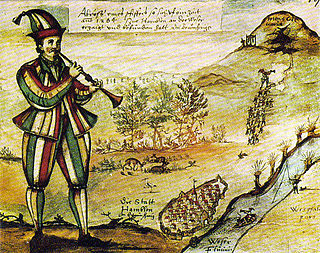
The Pied Piper of Hamelin is the titular character of a legend from the town of Hamelin (Hameln), Lower Saxony, Germany. The legend dates back to the Middle Ages, the earliest references describing a piper, dressed in multicolored clothing, who was a rat-catcher hired by the town to lure rats away with his magic pipe. When the citizens refuse to pay for this service as promised, he retaliates by using his instrument's magical power on their children, leading them away as he had the rats. This version of the story spread as folklore and has appeared in the writings of Johann Wolfgang von Goethe, the Brothers Grimm, and Robert Browning, among others.

John Caius, also known as Johannes Caius and Ioannes Caius, was an English physician, and second founder of the present Gonville and Caius College, Cambridge.
This article presents lists of the literary events and publications in 1524.

Werewolf fiction denotes the portrayal of werewolves and other shapeshifting man/woman-beasts, in the media of literature, drama, film, games and music. Werewolf literature includes folklore, legend, saga, fairy tales, Gothic and horror fiction, fantasy fiction and poetry. Such stories may be supernatural, symbolic or allegorical. A classic American cinematic example of the theme is The Wolf Man (1941) which in later films joins with the Frankenstein Monster and Count Dracula as one of the three famous icons of modern day horror. However, werewolf fiction is an exceptionally diverse genre, with ancient folkloric roots and manifold modern re-interpretations.
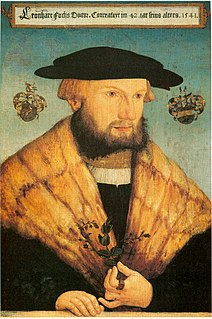
Leonhart Fuchs, sometimes spelled Leonhard Fuchs, was a German physician and botanist. His chief notability is as the author of a large book about plants and their uses as medicines, a herbal, which was first published in 1542 in Latin. It has about 500 accurate and detailed drawings of plants, which were printed from woodcuts. The drawings are the book's most notable advance on its predecessors. Although drawings had been used in other herbal books, Fuchs's herbal book proved and emphasized high-quality drawings as the most telling way to specify what a plant name stands for.

Caspar Peucer was a German reformer, physician, and scholar of Sorbian origin.

The Book of Abramelin tells the story of an Egyptian mage named Abraham, or Abra-Melin, who taught a system of magic to Abraham of Worms, a Jew in Worms, Germany, presumed to have lived from c.1362–c.1458. The system of magic from this book regained popularity in the 19th and 20th centuries partly due to Samuel Liddell MacGregor Mathers' translation, The Book of the Sacred Magic of Abramelin the Mage; and partly to its importance within the Hermetic Order of the Golden Dawn, and later within the mystical system of Thelema.
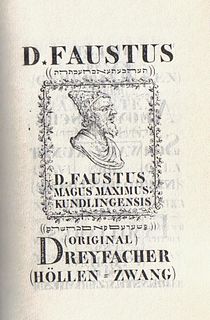
Johann Georg Faust, also known in English as John Faustus, was a German itinerant alchemist, astrologer and magician of the German Renaissance.
Hermann Finck was a German composer.
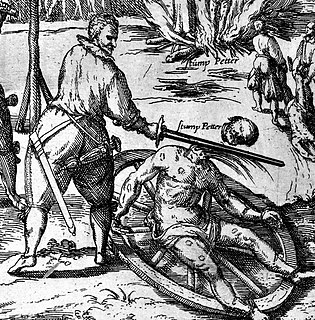
Peter Stumpp was a German serial killer and farmer, accused of werewolfery, witchcraft and cannibalism. He was known as 'the Werewolf of Bedburg'.
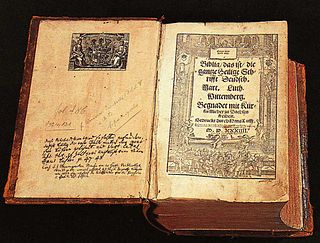
The Luther Bible is a German language Bible translation from Hebrew and ancient Greek by Martin Luther. The New Testament was first published in September 1522 and the complete Bible, containing the Old and New Testaments with Apocrypha, in 1534. Luther continued to make improvements to the text until 1545. It was the first full translation of the Bible into German which referenced the original Hebrew and Greek texts and not only the Latin Vulgate translation. However, according to the updated 2017 translation of the Luther Bible published by the Evangelical Church in Germany noted that "Luther translated according to the Latin text." Luther did not speak Greek, Hebrew or Aramaic well enough and relied heavily on other scholars for assistance, namely philologists Erasmus and Melanchthon. The text basis of the New Testament was the Greek Translation recently published by the Dutch Catholic Humanist Erasmus of Rotterdam called the Novum Instrumentum omne.

"O Sacred Head, Now Wounded" is a Christian Passion hymn based on a Latin text written during the Middle Ages. Paul Gerhardt wrote a German version which is known by its incipit, "O Haupt voll Blut und Wunden".

In Greek mythology, Lycaon was a king of Arcadia who, in the most popular version of the myth, tested Zeus' omniscience by serving him the roasted flesh of Lycaon's own son Nyctimus, in order to see whether Zeus was truly all-knowing.
Peter A. Olsson is an American psychiatrist, psychoanalyst and author. He is author of the book, Malignant Pied Pipers of Our Time: A Psychological Study of Destructive Cult Leaders from Rev. Jim Jones to Osama bin Laden.
The Pied Piper of Hamelin has appeared many times in popular culture.

In mythology and literature, a werewoman or were-woman is a woman who has taken the form of an animal through a process of lycanthropy. The use of the word "were" refers to the ability to shape-shift but is, taken literally, a contradiction in terms since in Old English the word "wer" means man. This would mean it literally translates to "man-woman".

The Responsories by the German composer Max Reger are 20 short settings of mostly biblical texts in English, to be used as responsories in Lutheran church services. Composed in 1911, they were first published in Philadelphia in 1914 as The Responsories.

Johann Heinrich von Heucher was a German physician and botanist.
References
- ↑ "Landesbibliothek MV - Ergebnisanzeige Personalschriften". Db.lbmv.de. Retrieved 2013-10-08.
- ↑ "The Book of Were-Wolves: Chapter V. The Were-Wolf in the Middle Ages". Sacred-texts.com. Retrieved 2013-10-08.